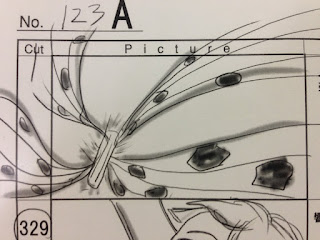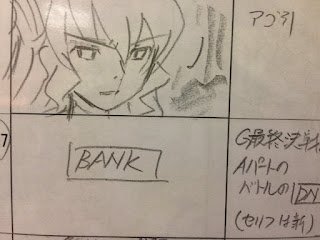
Although I had hoped to update the blog more frequently after H&D finished subbing GX, various things have gotten in my way and I haven’t had time. This will likely continue for the next few months, but I’m still going to try to update when I can. Recently there have been some significant merchandise announcements that I’d like to cover in a more comprehensive post, but for now I’ll just mention that the GX design artbook and staff book were announced for a February release next year. To celebrate that I’m going to make a few posts to share some production materials I’ve gotten my hands on over the past months.
Back when season 1 aired I wasn’t very knowledgeable about
the production side of anime and I didn’t realize that it was possible to get
your hands on production materials through various websites like Yahoo Auctions Japan and Mandarake. In fact, Mandarake has a whole section of their store at
Nakano Broadway dedicated strictly to production cells, storyboards, design
sheets and more things from many different anime. The sad side of this is that usually
these are sold to the store by animators looking to make some extra money to
supplement what is considered by many to be a meager income. Anime production can
be called a labor of love because many animators work overtime to produce the
best work they can, without getting paid extra. So while it can be frustrating
knowing that these documents are leaked as a result of an industry with a problem
that sorely needs fixing, the upside is that production documents that normally
don’t get released find their way into the hands of fans and collectors.
I’ve mentioned before that sometimes the prices on these
auctions can get ridiculously high, but if you’re persistent and keep your eyes
open sometimes you can get lucky. I try to balance my spending so that not too
much of my money is going to these second-hand auctions because obviously the
series needs support on the official side as well, however as a collector I
often find it hard to pass by on documents that I might never get the chance to
see again. For season 1 I was only ever able to obtain the storyboard for
episode 1, which I found very interesting and have always wanted more. Fortunately,
the BD/DVD release for season 2 actually included copies of the storyboards for
every episodes as a special feature on the disks. However, when the details of
GX’s release were announced I noticed that this feature was sadly missing and
have since made it my mission to pick up and maintain what I can as part of my
library.
On the whole, storyboards don’t really offer a deep look
into the production side of things because they are generally identical to the episode
itself. It’s rare to find discrepancies in the storyboards and the only things cut are small scenes that only last a couple frames. However, this doesn’t
mean that they aren’t interesting to look at and actually contain a fair amount
of unique information. One of the first things you notice when you look at a
storyboard is the art. It can vary depending on which staff member drew it. Some
storyboard artists take their time and have a fairly detailed style, others
stick to the fact that a storyboard is simply meant to provide a rough outline
and make incredibly simple drawings. I’ve noted in the past that this can result in some very hilarious and very terrifying faces.




On the other hand, there are also times when a scene is important or requires more detail in order to convey what the director wants and so you’ll find faces that are almost spot on with the final result. This can also perhaps be attributed to the particular artist in question and whether they have an affinity for a certain character or not.


Another important thing about the art is that it can convey certain aspects differently than the final product. During production, especially for Symphogear, a lot of changes can be made to scenes visually when left in the hands of individual animators and so looking at the storyboards may give us a better idea of the original intent of some scenes, such as the use of "sheet music" effects in the GX transformations.


To go along with this, storyboards contain a lot of specific written direction. Beside each image is text that clearly conveys what the director or writer want from a specific scene. The most common details refer to character’s facial expressions or body language, since that has to be carefully conveyed through the animation. A good example of this is Carol's "deranged" face from episode 11, or the "change" in Miku's face in episode 1 when Ando inquires into Hibiki's family (because she knows it's a sensitive topic).


Sometimes the design aspects of the series can be found in the storyboards. Usually markings or backgrounds have their own design sheets which animators refer to separately from the storyboard, but sometimes the storyboard will make a clear reference to how something should be drawn, particularly if it’s the focus of a scene. A good example of this is the use of the United Nations logo and the use of real-world Yokohama as a backdrop in episode 1 of GX. The images featured in the storyboards aren't drawn, but actual pictures.




One other interesting thing to note is when there are no pictures. Fans of anime will no doubt be familiar with the idea of “stock footage” or “recap episodes,” which consist entirely of animation that was drawn previously. In this case the storyboard artist doesn’t re-draw the scene, but simply refers to the existing footage by writing the English word “bank.” This refers to the stock of footage they can pull from, and in Symphogear’s case this can usually be found when a transformation scene is used. However, it also is used for flashback scenes which include a note for the season, episode, and particular scene that will be featured.


Overall, I enjoy looking at the storyboards to see how the series was constructed visually. It’s always fun to see the way action is conveyed through the storyboards and how they managed to put together some of the more intense scenes. Often times you'll find neat little reference images outside of the main frame that further expand on poses or movement.


Now as I said earlier it’s rare to find differences in the storyboards, but they do in fact exist. Usually they are very subtle things, such as a character’s pose or an angle of a shot dropped for time or because it doesn’t fit the flow. Occasionally though you will find something significant. This happened a lot in the storyboard for episode 1, season 1. Probably because the series was so early in production a number of things hadn't been decided on yet. For example, did you know that Hibiki's strict female teacher was originally...a dude with a 'fro?


And at one point Kanade's "Stardust Photon" and "Last Meteor" were actually called "Unlimited Shot" and "Rifling Blast." The directions also note the font should be "American comic book style."




Here's a brief scene that was cut. In episode 1, Tsubasa goes to back-up the army who are "fighting" the Noise and she easily wipes them all out. As the army guys stand around dumbfounded, Genjuro rolls up in a car with a megaphone and starts explaining that Div 2 will take over from here.


Here's some of the more subtle changes in GX. For example, in episode 11 when Tsubasa prevents Carol from escaping by using her big sword, she stands at the top of it not with her arms crossed but with them on her hips.


Or in episode 13, when all of the girls are fighting off the Noise in their X-Drive forms they turn back to Carol to find her powering up. Hibiki realizes that the Noise were just a distraction. Originally this was supposed to be a bit more evident, because after fighting the Noise the girls actually lose track of where Carol is. There is a brief cut scene where Shirabe and Kirika look around before spotting her in front of the building.


Also, there is a rather notable difference in the final scene of episode 13 between the storyboard and the end product. Makes you wonder what sort of conversations were had in the production offices to determine how this should be represented.


Well, that covers just about everything about the
storyboards. I hope you enjoyed this look into the series and in the future I
plan to make this content more thoroughly available for everyone when I have more
time and resources. For now, look forward to the next installment:
backgrounds.











Cool. BTW did you hear about s4 being confirmed?
ReplyDeleteDo you have any idea if all the symphogear ost is already released? The beef strognoff song is not in any cd yet ;_;
ReplyDeleteYeah, the GX OST came with BD vol 2 and did not include the Beef Stroganoff song. As far as I know, they haven't said it will be released individually so a rip of the audio from the episode is probably the best you'll get. :\
DeleteCan You Send Me Images Of GX Episode 3 Storyboards?
ReplyDelete